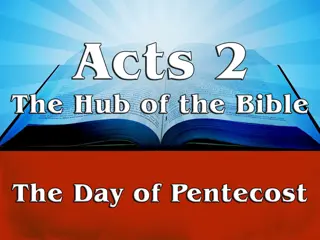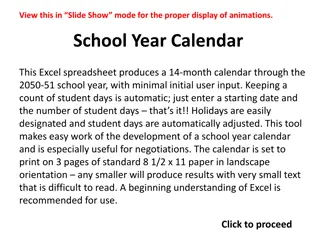Exploring Passover: Symbolism of Spring and Jewish Calendar Insights
Learn about the Festival of Spring in Israel and the symbolism of Passover, commemorating the Israelites' exodus from Egypt. Discover the significance of Passover occurring in the spring and how the Hebrew calendar's lunar nature affects holiday seasonality. Explore Hebrew language connections to the lunar calendar, and engage in outdoor activities to observe the arrival of spring.
Download Presentation

Please find below an Image/Link to download the presentation.
The content on the website is provided AS IS for your information and personal use only. It may not be sold, licensed, or shared on other websites without obtaining consent from the author. Download presentation by click this link. If you encounter any issues during the download, it is possible that the publisher has removed the file from their server.
E N D
Presentation Transcript
Materials for Passover Unit 5 Kitah Bet / Second Grade Olam Tikvah Religious School
In this unit we will Learn about the Festival of Spring In Israel, like in many other places, Passover symbolizes the arrival of the spring. Look at the variety of spring flowers in Israel .
Passover commemorates the Israelites' exodus from Egypt, and their freedom from slavery. In the book of Exodus, God commands the Israelites to observe Passover in the spring. The Torah stresses on the fact that Passover occurs in the spring. In fact, in biblical times, the month in which the holiday fell was even called Aviv, which means spring. (Now we call that month Nissan). Month = Spring =
The Jewish year (which is lunar/according to the moon) is shorter than the Gregorian/regular year (which is solar/according to the sun). Because of this Passover might have eventually occurred in different seasons. Therefore, there is a Hebrew/Jewish leap year every four years, which ensures that the Hebrew/Jewish calendar remains synchronized with the solar cycle so that the holidays are celebrated in the right season. While the Gregorian leap year has one extra day (February 29th), the Jewish leap year has an entire extra month (every year we have the happiest month of the year the month of Adar - twice!). Why do you think it is important for Passover and other Jewish holidays to always occur in the correct seasons?
Fun Hebrew Fact: The Hebrew word for month is Khodesh/Chodesh ( ). The Hebrew word for new is Khadash ( ). In the lunar Hebrew calendar, a new month begins with a new moon. Therefore, the word for month and the word new in Hebrew are from the same family and share the same three letter root . . . Passover is in the middle of the Hebrew month of Nissan. What do you expect the moon to look like then? Be sure to go outside and check the moon just before or just after the Seder! Draw a picture of what you see.
Passover is almost here and indeed, Spring has begun! Go out in the yard or take a walk in the park (with your parents), and observe all the signs sights, smells, sounds - that spring is here (or almost here)!
Simcha Raba (Great Joy) = A popular Pessach song in Hebrew says in its chorus: Great joy, great joy, Spring has arrived, Passover has come And in Hebrew: , , Try reading the Hebrew out loud and singing the chorus along with the song, at https://www.youtube.com/watch?v=3mFp_D_9hLQ
Enjoy listening and singing along to some more holiday songs: https://www.youtube.com/watch?v=0VeH2DARmFE https://www.youtube.com/watch?v=BRWNrk7FxG4 https://www.youtube.com/watch?v=j99bU7X67mI&t=29s
Lets review our new Hebrew vocabulary. First try to read the Hebrew words out loud, then match them to the English word with the same meaning: Festival/holiday Joy/happiness Spring Month New























